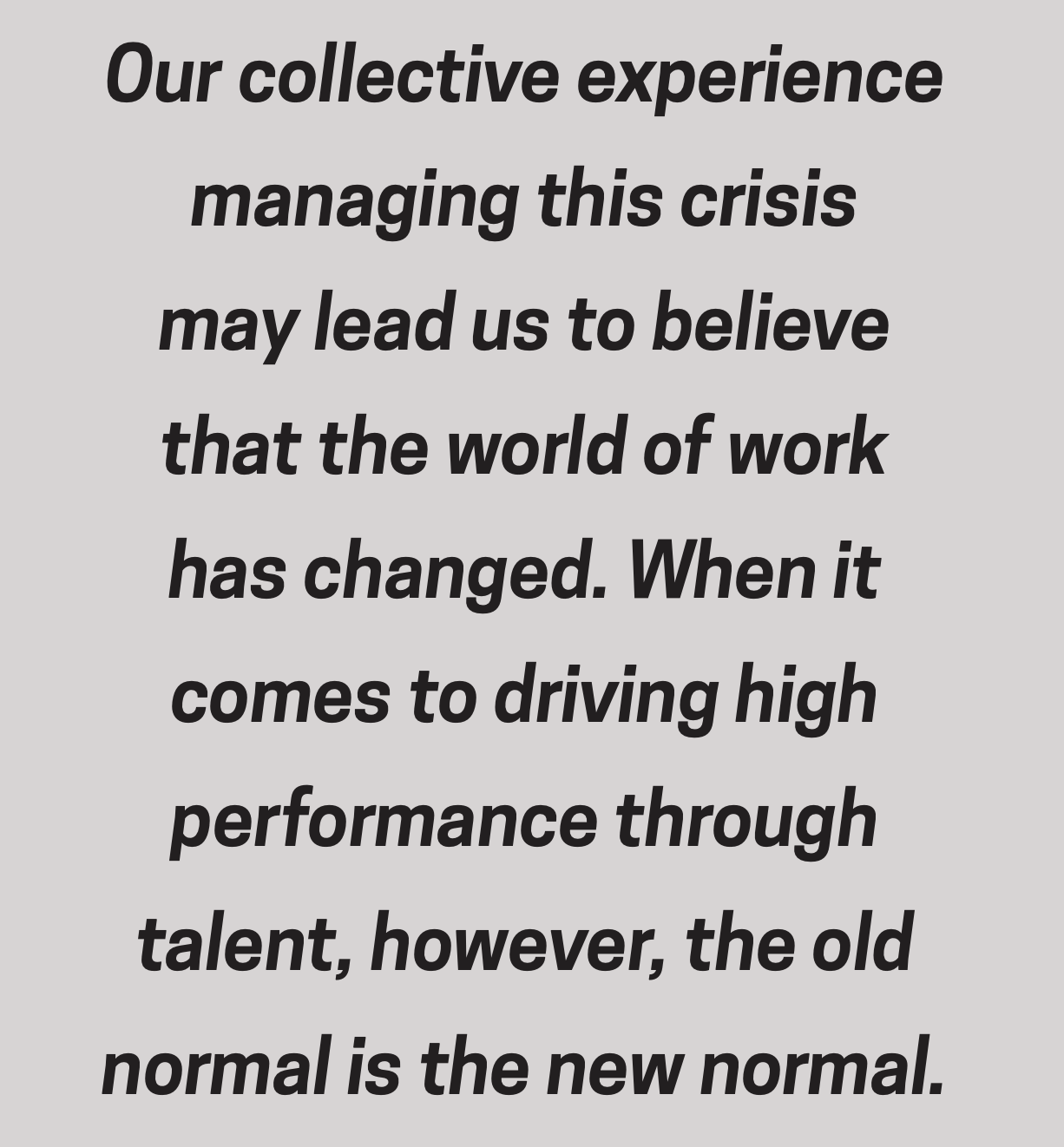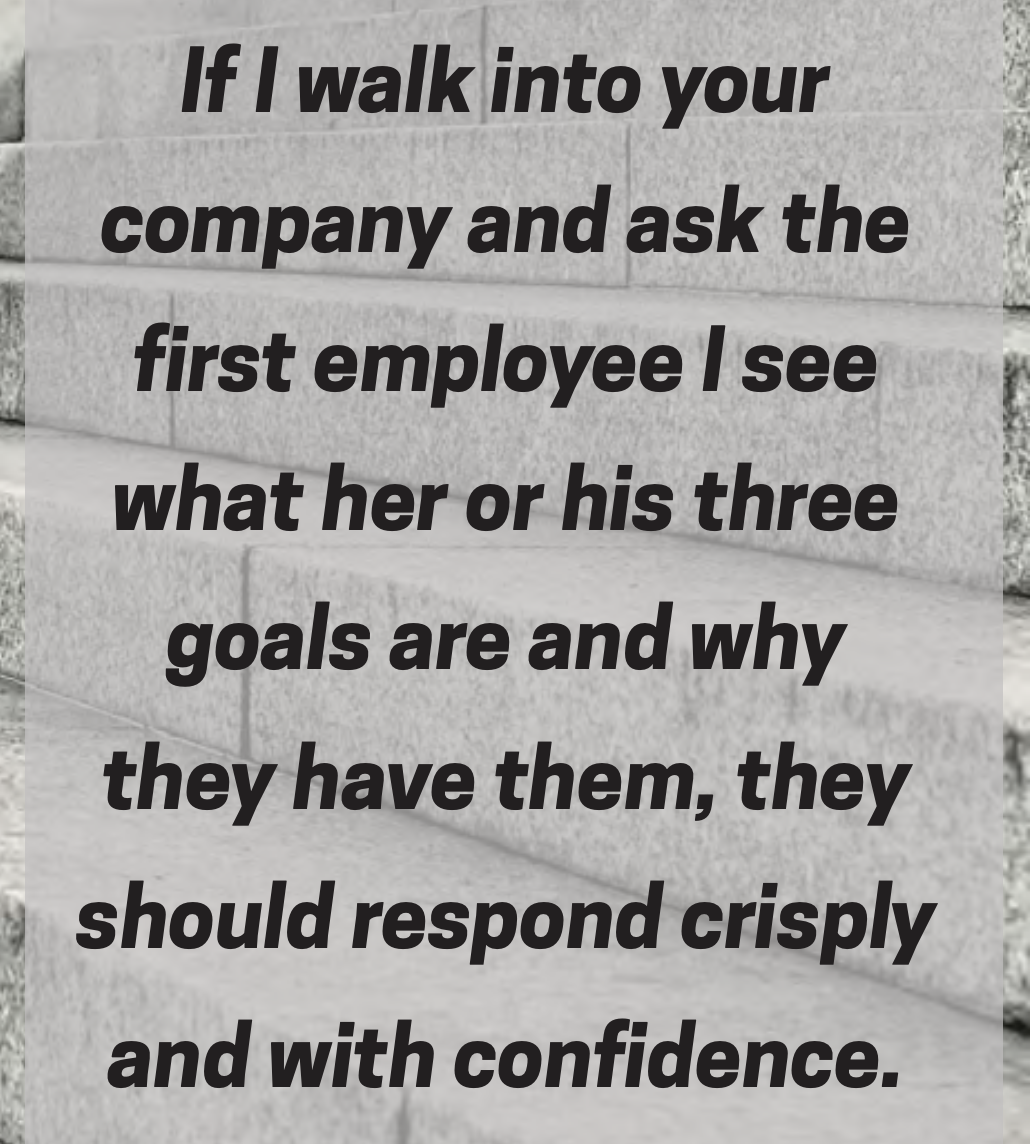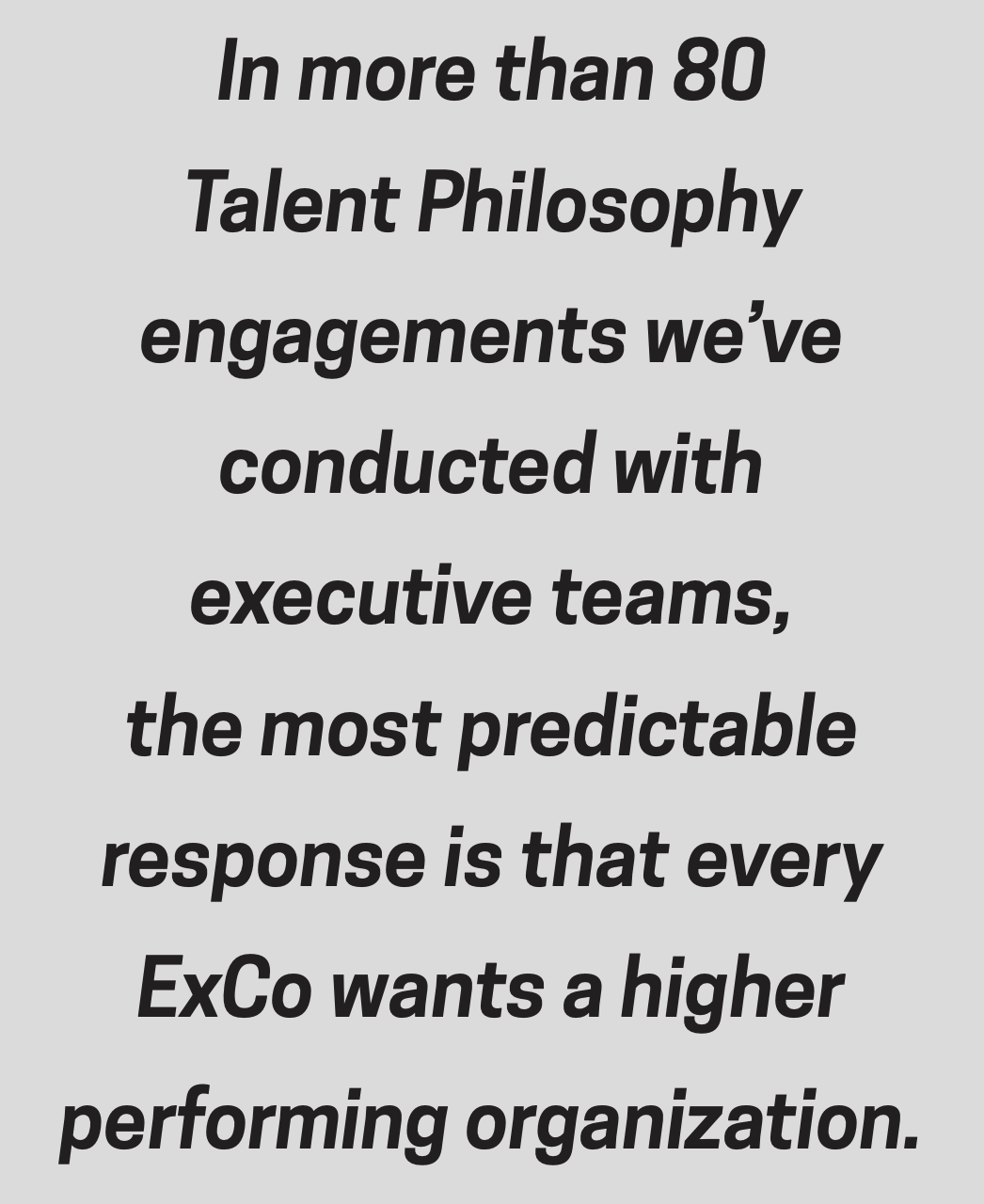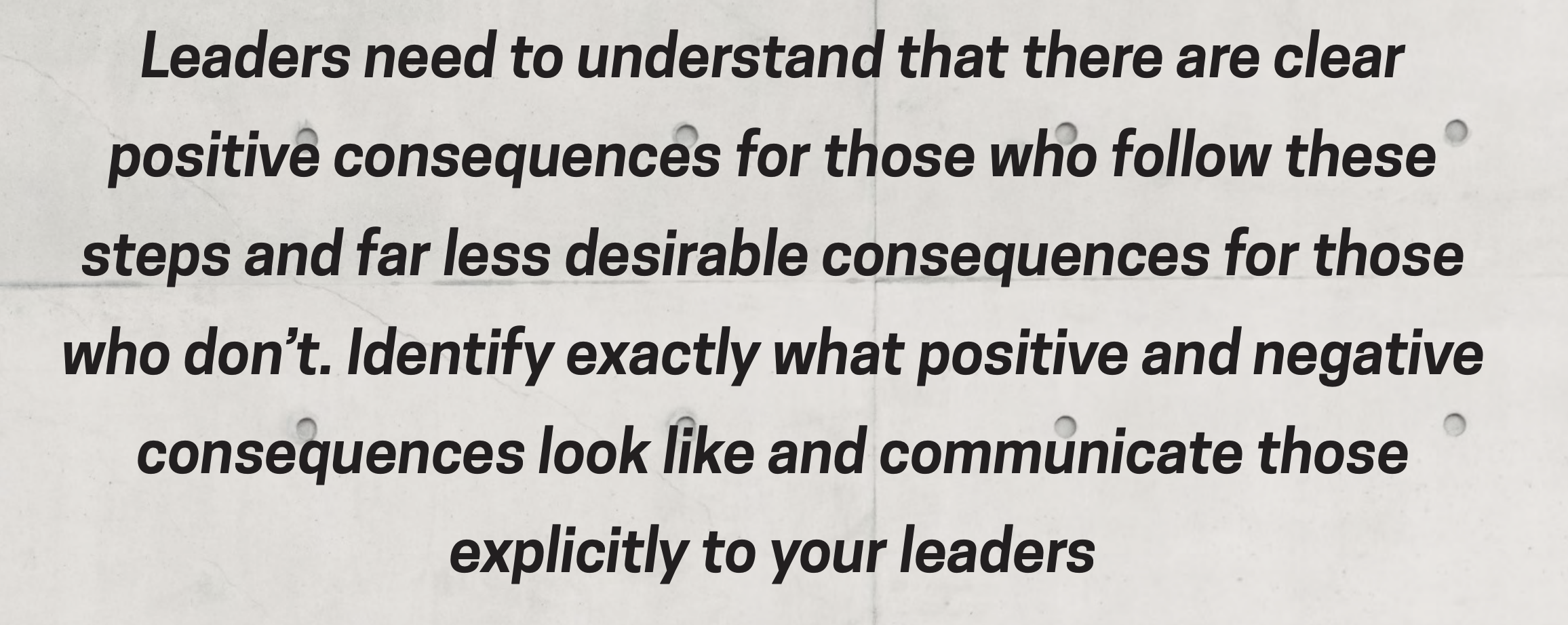Please enter your email in order to download this publication.
By Marc Effron, President, Talent Strategy Group
It’s understandable that HR’s recent focus has been on employee safety and security. The function has responded admirably to unprecedented demands and unforeseen challenges. As we see the global situation starting to turn, it’s important to refocus our efforts on helping our companies quickly recover.
Our collective experience in managing this crisis may lead us to believe that the world of work has changed. When it comes to driving high performance through talent, however, the old normal is the new normal.

Companies still need employees to have clear goals and direction. High potential leaders still need to be identified and grown. Managers still need to be held accountable to elevate both what and how their team delivers. The fundamentals of winning through talent remain the same.
What has changed is that those needs will be even more urgent during the next 18 months. That urgency is not the result of a changing world, but of incredible and increasing pressure on companies to recover quickly – to show strong progress in 2020 and strong results in 2021.
Markets may forgive weak results this year, but unless you’re in the airline, hospitality, or tourism business, they won’t forgive them any longer than that.
If you wonder what lack of forgiveness sounds like, consider this: Private equity investors were sitting on $1.5 trillion of cash at the beginning of 2020. These PE firms exist to find undervalued or under-performing companies, then buy them, transform them, and sell them for a large profit.
By “transform,” I mean strip out waste and replace leaders who can’t or won’t make the tough decisions necessary to aggressively compete. These firms will wait patiently for a few months as the market settles and act with speed and decisiveness after that.
What this means to you as CHRO is that the pressure to get high performance through talent matters more than ever. It will be your absolute best talent, leading others in your organization, that will allow you to meet the needs of demanding shareholders and to keep the private equity bears from your door.
Your Talent Plan For The Recovery
We believe that any company can prosper over the next 18 months if they focus on the few most powerful, scientifically proven drivers of high performance. This is your Talent Plan for the Recovery and I personally promise that your organization will be a stronger competitor in December 2021 if you execute these actions.
1. Focus Everyone On Their Few, Big, Aligned Goals
Your leaders don’t have eight, ten, or twelve important things to accomplish in 2020 or 2021. They have three or four. One could argue that this is true every year, but that mindset is essential in a period where a strong recovery may be paramount to your company’s survival.
Since scientific research is unbelievably clear that big, focused goals drive higher performance, your talent plan begins here. It’s your role to force the disciplined conversation that will lead to a few, big aligned goals.
If your organization delayed goal setting due to the crisis, you have a wonderful opportunity to lead your executive team in an organic discussion about which three actions will allow your company to emerge with strength. Your objective is to identify the most powerful outcomes that either your company can deliver and your competitors can’t, or that many companies can deliver but your company can flawlessly deliver.
If your company has already set goals for 2020, hold an ExCo session in June where you review those goals and identify the three most important results to deliver during the next six months.
These sessions need to quickly roll-down at least three to four layers in your organization to ensure focused, aligned, individual goals for every leader.
My test for success on this step is easy. If I walk into your company and ask the first employee I see what her or his three goals are and why they have them, they should respond crisply and with confidence.

2. Fill Your Critical Roles With 90th Percentile Talent
Which 10 roles in your company are most critical to strong performance over the next 18 months? Are the people currently in those roles 90th percentile or better talent? This is an easy, powerful question that few companies regularly ask themselves and it’s important to ask it the right way.
The question you should ask is not, “Is Bob one of our best?” It is, “For the _______ role, is it possible to find better quality talent in the world than Bob? If it is possible, what is our reason for not having that talent in this role?”
Executives typically don’t ask that question because they don’t want to hear the answer or deal with its consequences. Your company is far more likely to win in the next 18 months if you field the most competitive team.
Transparency about your talent is essential if you’re going to achieve that outcome. Stop using the excuse of having a “nice” culture in order to avoid those tough talent discussions.
By the way, PE firms love companies with a “nice” culture. They know that your corporate politics, lack of transparency, and poor talent choices will make it even easier to reap huge profits when they replace your mediocre talent with top talent and they force direct and honest conversations about people and the business.
3. Identify Your Performance-Differentiating Behaviors
Your company has a leadership competency model, values model, or a similar guide to help leaders understand what’s valued at your organization. We find that these models are normally a generic mix of good-citizen behaviors and a few select references to performance or leadership. That model is wholly insufficient to drive performance through talent over the next 18 months.
You need to clarify the three behaviors that will drive high performance during that period. These behaviors should be defined in one sentence each, using language that every employee can understand and that your investors would give you a standing ovation for if they saw every employee demonstrate them.
It’s simple to create that model. Assign a high potential HR leader to interview your executive team and ask each of them the simple question, “What three behaviors are most critical to our success over the next 18 months?” They should find enough similarity across those interviews to identify the three common themes and phrase them in a way that sounds like your company.
If they don’t find commonality, then they need to present their findings to your ExCo and ask them how they want to manage their disparate opinions.
Once those success behaviors are identified, they need to replace your current leadership behaviors in the most powerful talent processes you have – goal setting, performance assessments, talent reviews, leadership development and compensation. Those three behaviors are your true north until at least December 2021 and you must continuously redirect everyone in the company towards them.
4. Make Leaders Actively Manage Performance
In more than 80 Talent Philosophy engagements we’ve conducted with executive teams, the most predictable response is that every ExCo wants a higher-performing organization.

We tell them that higher performance is a consequence of two very simple, if not easy, actions. Their leaders need to set very clear goals and they need to shorten the performance cycle.
How to set clear goals is straight-forward and we described it in #1 above. To shorten the performance cycle, leaders must more quickly “catch” and correct slipping performance. The question can’t be, “How did Bob do this quarter?” It must be, “How is Bob doing this week and what are we doing to ensure his high performance next week?”
This requires that managers more actively manage their teams, checking in with direct reports on a far more regular basis to understand their progress towards goals. The moment that progress slips or goes off course, managers need to know and help correct it.
You only have 18 months to execute this plan. You can’t afford to lose one of those months because some managers weren’t paying attention. Isn’t that micromanaging, some of you may ask. No, it’s managing for high performance.
The Road Ahead
The foundation for each of these steps is consequential accountability for leaders to execute them. Leaders need to understand that there are clear positive consequences for those who follow these steps and far less desirable consequences for those who don’t. Identify exactly what positive and negative consequences look like and communicate those explicitly to your leaders.

It’s going to be a challenging, scary, competitive world for our companies over the next 18 months. As a CHRO, your most important purpose right now is to equip your company to win through talent.
We know which steps will allow us to achieve this – the fundamentals haven’t changed. The importance of executing those fundamentals has.
More About The Author:
- Marc Effron, President, Talent Strategy Group
- Marc founded and leads The Talent Strategy Group and consults globally to the world’s largest and most successful corporations. He co-founded the Talent Management Institute and created and publishes TalentQ magazine. He co-authored the Harvard Business Review Publishing best-seller One Page Talent Management and 8 Steps to High Performance.
